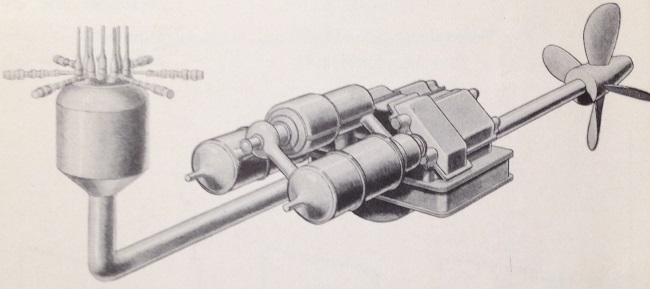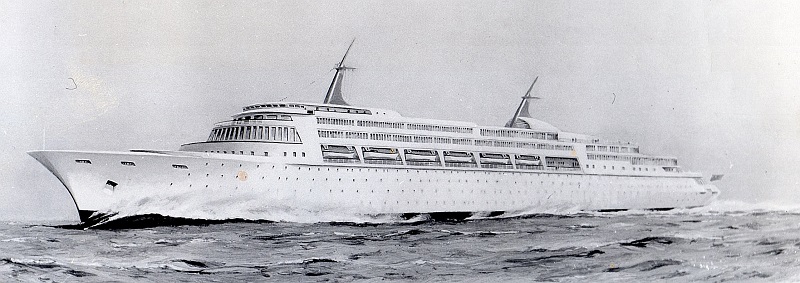Smorgasbord or Specialty? Nuclear Ships and Now
At the end of last month there was some press about the emissions from cargo ships as a threat to the environment, and in due course nuclear propulsion was brought up as a way to get around it. It seems that every once in a while nuclear propulsion for cargo and/or passenger ships is revived, only to be forgotten again after a few superficial studies. The plain fact seems to be that the economics of nuclear ships will not allow their wide spread until something external re-racks the whole economic model of shipping to allow this option to be considered. That "something" is very likely to be penalty for emissions near shore, or for burning fossil fuel in ships in the first place - in other words, some form or another of carbon taxing applied specifically to open-ocean shipping.
Seeing that there's some momentum behind this principle generally for power generation and transportation, it could be we're due for another revival of nuclear commercial ships - at least, on paper, anyway. I'd like to go over a couple of the "lessons learned" from the time when it was actually done.
Design to fit or fit to design?

This American Turbine Corporation concept for a gas cooled nuclear shipboard plant from the late 1950's was one of a range that was intended to be inserted into existing designs or existing ships. That only happened once, and the reactor was water cooled. The US Navy decided never to operate gas cooled reactors on subs because Admiral Rickover worried about the gas potentially leaking into the sub, asphyxiating the crew - a problem not nearly so menacing with conventional ships on the surface.
The whole nuclear field in the 1950's was pretty much convinced that what was needed was a smorgasbord of nuclear plant designs from low to high shaft powers. These, it was presumed, could be substituted in existing ship designs in order to "nuclearize" them, for lack of a better term. This didn't work out for a number of reasons.
Once it was realized that the plant of the NS SAVANNAH - the only commercial nuclear ship actually completed here - was far too large to allow it to simply be inserted into existing designs something else had to be done. This was the impetus that developed integral reactors, with reactor, steam generators and pumps in or on a single vessel. That concept really did work and was actually applied in the OTTO HAHN, which was a former fossil powered ship converted to nuclear.
In both cases though the economics just weren't there. Not only was there insurance to carry but there were very high crew costs - nuclear trained ship operators cost a lot more than conventional ones, and after some labor disputes surrounding the NS SAVANNAH in the early 60's it became clear that their pay would have to be high. These factors together, as well as construction cost, made it apparent that really small nuclear powered ships weren't going to happen.
As it turned out the solution was to have either very large ships, whose enormous cargo capacity could pay for the higher costs or, conversely, to have an extremely fast ship so that premiums on shipping (or passenger tickets) would cover the bills. From the middle 1960's on through when the nuclear industry here in the United States stopped actively designing and proposing nuclear ships the focus moved to very large ships and very high (roughly 120,000 SHP) power outputs that would be required to move these large ships.
Where to Go?
Most people today have either forgotten or never known that half of the job that the NS SAVANNAH did was political. That's right; the ship was an emissary of sorts. There were many places in the world that nuclear powered vessels (pretty much, US nuclear subs) in the 50's and 60's were not welcomed. In order for there to be any real prospect of having nuclear ships on the high seas they had to be able to enter ports and conduct trade. The NS SAVANNAH, as a national showboat of sorts, played a pivotal role in the international diplomacy required to convince people (and governments) that the ships would be safe and that there was real value in signing actual agreements to allow nuclear powered ships to enter ports around the world. The SAVANNAH and the OTTO HAHN procured dozens of such agreements - but there's no doubt that these would all need to be revisited today in 2019 if we were to suddenly decide we wanted to select the nuclear ship option. In a post-Fukushima, social-media and misinformation-heavy world we may have quite a fight in front of us to get this crucially important part of the puzzle in place. And that brings up my final point.
It's Actually OK

1963 concept art showing 24 knot, 30,000 ton passenger ship designed in the UK to carry 1500 passengers. According to the information obtained with the photo the ship was planned with two reactors, type unknown. Photo courtesy United Kingdom Atomic Energy Authority.
There's really only one way that nuclear powered ships will ply the oceans in numbers, and that's if the general public is convinced that cargo carried on the ships (whether it's oil or autos, clothes or cans) is just as safe as if it were carried any other way. And, there again, the only way people will get on a nuclear powered ship is if they're assured - but not overly assured - that it's safe. (After all, if you say something's safe one too many times people begin to think they're being deceived.) The NS SAVANNAH did that back in the 1960's. It proved both; it got the nuclear powered ship into the newspapers, on the news reels and even on television. It showed them, in person.
What do we boil out of this? It's simple - we need another NS SAVANNAH. That is to say, another prototype. A modern one, perhaps with an advanced and highly compact reactor. Something that works well in a water environment (sorry, salt and sodium!) and something reliable. Only then can we actually get the miles over the waves and hours on board so vital to (re)proving the concept of commercial nuclear powered ships. The prototype ship should be designed to carry a useful cargo, but what's really needed is not just proof of concept but proof of reliability and safety - to people on board. So, the "showboat" angle actually matters quite significantly. I think that would be a great way to start. We could even consider repowering an existing ship - quite the reverse of the earlier findings - but a purpose-built one would be far, far better.
What do you think? Please feel free to leave a constructive comment for the author below. (He'd love to see this sort of thing get some inertia.)
 Will Davis is a member of the Board of Directors for the N/S Savannah Association, Inc. He has been a contributing author for Fuel Cycle Week, and he used to write his own popular blog Atomic Power Review. Davis is also a consultant and writer for the American Nuclear Society, and serves on the ANS Communications Committee and the Book Publishing Committee. He is a former U.S. Navy reactor operator and served on SSBN-641, USS Simon Bolivar. His popular Twitter account, @atomicnews is mostly devoted to nuclear energy. He has an Instagram at @williamdavis5500, but that's mostly dog photos. In the photo here he's standing in the control room of NS SAVANNAH.
Will Davis is a member of the Board of Directors for the N/S Savannah Association, Inc. He has been a contributing author for Fuel Cycle Week, and he used to write his own popular blog Atomic Power Review. Davis is also a consultant and writer for the American Nuclear Society, and serves on the ANS Communications Committee and the Book Publishing Committee. He is a former U.S. Navy reactor operator and served on SSBN-641, USS Simon Bolivar. His popular Twitter account, @atomicnews is mostly devoted to nuclear energy. He has an Instagram at @williamdavis5500, but that's mostly dog photos. In the photo here he's standing in the control room of NS SAVANNAH.

